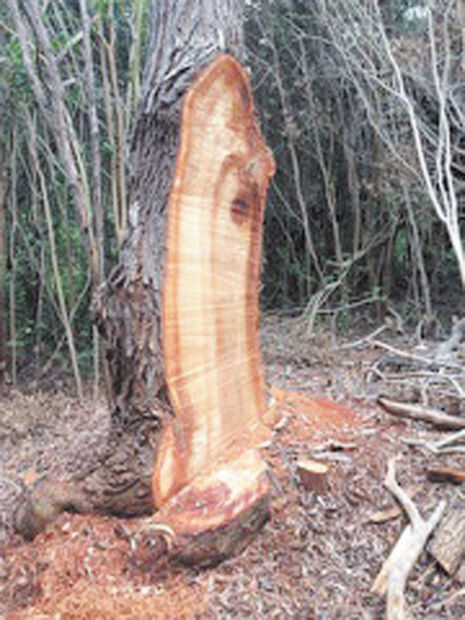LIHUE — Every summer, Ramona Costa returns home to Kauai from Maui to spend a month in Kokee State Park. It’s a tradition she says started when she was a young girl. “My father always taught me to love our
LIHUE — Every summer, Ramona Costa returns home to Kauai from Maui to spend a month in Kokee State Park. It’s a tradition she says started when she was a young girl.
“My father always taught me to love our mountain because it is what keeps us alive,” she said. “I love my mountain. I love Kokee with all my heart.”
During this year’s trip, Costa came across a pair of fallen koa trees, with large chunks of the high-value wood stolen by poachers.
The sight broke her heart, she said.
One of the trees, located on a hiking trail near Puu Hina Hina Lookout, was cut vertically down its trunk and still standing, with its dark red core exposed. Fresh sawdust, just a day or so old, laid on the ground, according to Costa.
“Literally brother, I held onto the trees and cried like a baby,” she said. “I could feel my trees being killed.”
Theft of koa is a problem that continues to persist in the park. And finding a solution has not been easy.
“Amounts taken vary from scene to scene,” Deborah Ward, the information specialist for the Hawaii Department of Land and Natural Resources, wrote in an email. “Thefts appear to be increasing and in areas more visible to DLNR officials and the public.”
Ward said the most recent thefts have been occurring almost monthly on state park lands. State forests have also been affected, approximately every four to five months.
“DLNR’s Division of Conservation and Resources Enforcement is investigating recent cases of theft of koa at Kokee State Park, as well as other pending cases,” Ward wrote. “The majority of thefts have been on State Parks lands, most recently last week on park land, and in June 2013 in the Na Pali-Kona Forest Reserve.”
Ward declined to comment on the quantities of wood stolen during recent incidents. And she could not provide information about what measures, if any, DLNR is taking to address the issue.
“I can’t answer that question since it bears on investigation,” she wrote.
Costa is convinced the wood is being stolen by a small group of jewelry or furniture makers on Kauai. She said whoever it is has no business being on the sacred mountain, where several of her ancestors are buried.
“This was really emotional for me, to see my mountain being raped like that,” she said of the recent experience. “These trees are supposed to be protected.”
One of the proposals in the yet-to-be-approved master plan for Kokee and Waimea Canyon state parks is to construct an entry station to collect user fees from non-residents.
Chipper Wichman, chief executive officer of the National Tropical Botanical Garden and a member of the Kokee State Park Advisory Council, said over the years there have been discussions about the koa theft problem and how the entry station could potentially provide enhanced security, deterring poaching and other illegal activity.
However, Wichman said the entry station has been misrepresented, as the revised master plan only calls for it to be manned during daytime hours.
“It’s primary purpose was revenue generation,” he said. “A possible secondary purpose is enhanced security on the mountain, but only if they use some sort of camera system.”
Today, there is very little to deter koa theft in Kokee, according to Wichman. And unless a person is caught in the act, it is nearly impossible to prove the wood was harvested illegally.
Camera technology, Wichman said, could be easily implemented, even without an entry station.
“The real threat of koa theft on the mountain is from people who have an organized plan of actually hauling substantial (amounts),” Wichman said. “I’m not sure it’s a huge enough problem that you would build an entry station and have it manned 24-7.”
Last week, the KSPAC adopted a final report from its Permitted Interaction Group — an investigative body created in June to review important chapters of the master plan — and opted not to support the entry station.
Costa said she would be all for a gated entry station to keep people from steeling the wood, especially at night.
In a previous article in The Garden Island, Ward was quoted as saying the penalty for theft of a mature koa tree could be in the range of $50,000.
“We want to reiterate that it is illegal to cut down any tree in a state park or forest reserve without a permit,” she wrote in an email Sept. 26. “We also invite the public to help stop theft of public resources by reporting suspicious behavior in state parks and forests.”
The DLNR’s Division of Conservation and Resource Enforcement can be reached at 634-DLNR.
Endemic to Hawaii, koa was historically used by Hawaiians to build canoes and paddles. In the Hawaii language, koa means brave, bold, fearless and valiant.
Today, the valuable, sought-after wood is often used in fine furniture, crafts, bowls and instruments. Trey Anastasio, frontman of the rock band Phish, has even been a long-time rocker of koa hollow-bodied electric guitars.
• Chris D’Angelo, environmental reporter, can be reached at 245-0441 or cdangelo@thegardenisland.com.



